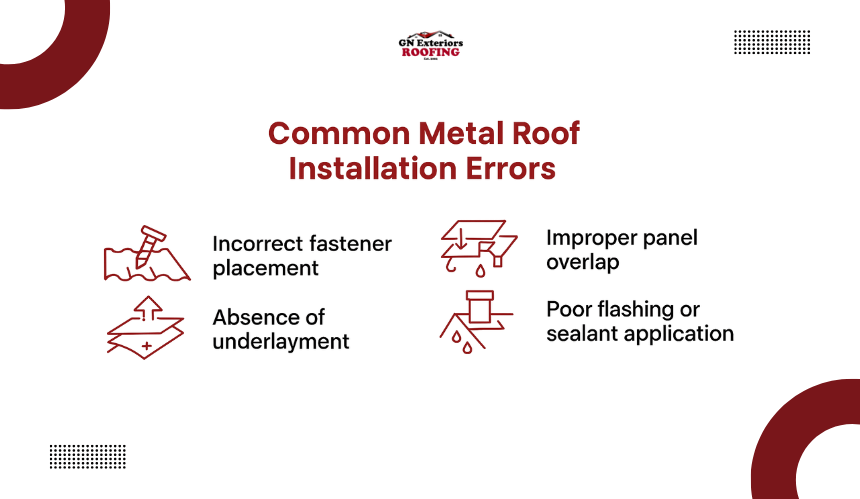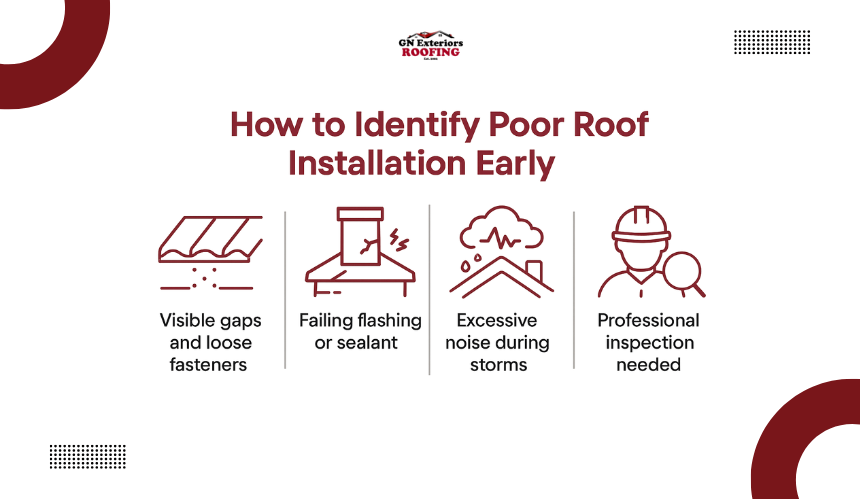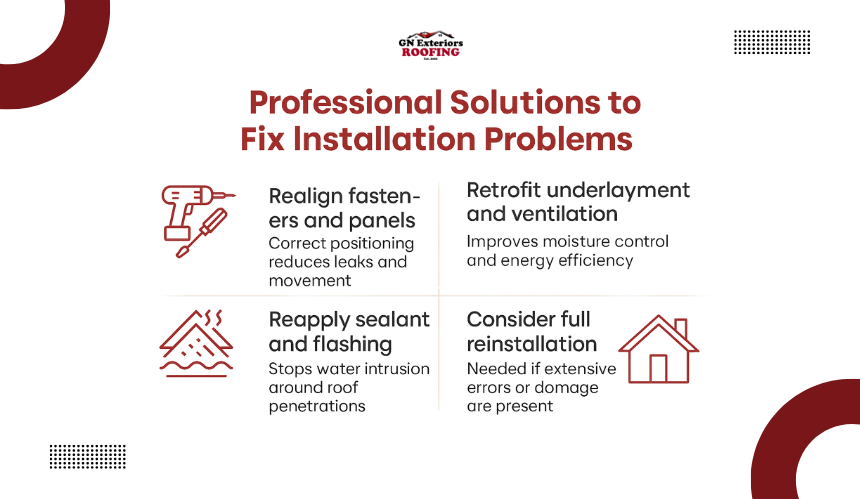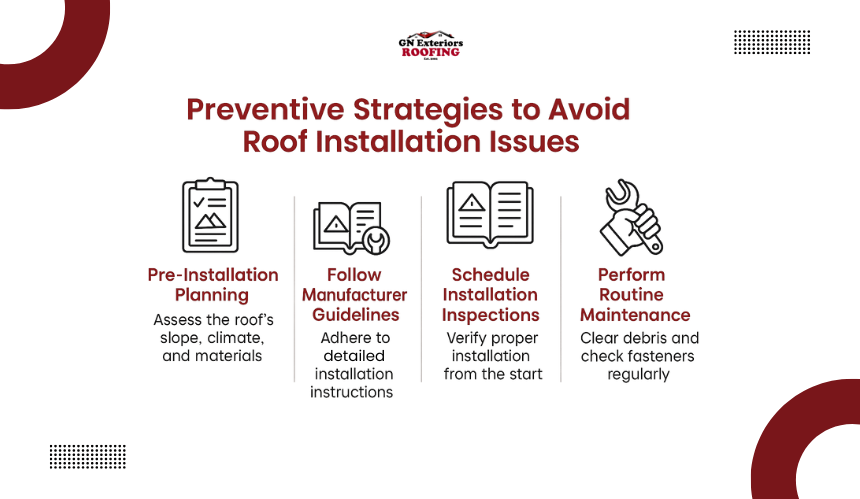
Metal roofing has become one of the most trusted choices for homeowners and businesses because of its long lifespan, energy efficiency, and resilience. Yet the advantages of this system can quickly disappear if the installation is not performed correctly.
Poor workmanship or cutting corners during installation creates hidden risks that may not surface immediately but can cause serious structural, financial, and safety issues over time.
Understanding these risks early is critical for anyone considering metal roofing or already living under one. This article explores the most common installation mistakes, the hidden problems they create, and practical solutions to address them before they escalate.

Even though metal roofs are designed to last decades, improper installation can shorten their lifespan and lead to costly repairs. By recognizing the most frequent mistakes metal roofing contractors or DIY installers make, homeowners can better protect their investment and spot early warning signs before issues escalate.
Fasteners secure panels to the structure, and when they are misaligned or overdriven, the roof becomes vulnerable to leaks and wind damage. Loose or exposed screws also create entry points for moisture, leading to rust and premature deterioration.
Skipping or using inadequate underlayment leaves the roof deck exposed to condensation and water infiltration. Over time, this can weaken insulation, cause mold growth, and reduce the thermal efficiency of the entire system.
Panels that are not properly overlapped or aligned create gaps where water and debris can enter. Poor alignment also places stress on seams during thermal expansion, increasing the chance of structural failure.
Flashing is critical around roof edges, chimneys, skylights, and vents. If installed poorly or paired with failing sealants, it allows water to penetrate into areas that should remain protected, often leading to hidden structural decay.
Without proper airflow, trapped heat and moisture can warp panels, damage insulation, and reduce roof longevity. Ventilation also prevents ice dams in colder regions, making it essential for year-round protection.

Catching installation flaws in the early stages can save homeowners from costly repairs and major disruptions. While many issues remain hidden, there are clear warning signs and practical steps that help identify whether a metal roof was installed properly.
Look for gaps between panels, loose or missing fasteners, or uneven seams that disrupt the roof’s alignment. Stains on ceilings or walls also indicate water penetration caused by poor sealing or flashing.
Inspect areas around chimneys, skylights, and vents. Cracked sealants, rusted flashing, or visible openings around these components are early indicators that installation was not done to standard.
Metal roofs should be properly secured to minimize movement. If the roof creaks, rattles, or makes unusual noises during high winds or storms, it often points to fastener misplacement or poor structural anchoring.
If early signs appear, scheduling a professional roofing inspection is the safest step. Certified contractors use checklists, tools, and moisture detection methods to uncover problems invisible to the untrained eye.
If you suspect your roof was not installed correctly, don’t wait until small issues turn into major expenses. The experts at GN Exteriors specialize in professional roof inspections, repairs, and complete installation services tailored to your property’s needs.

Once installation issues are detected, timely action makes all the difference. Professional roofing contractors have the tools, expertise, and training to address both minor flaws and severe structural concerns, helping extend the lifespan of the roof and protect your property.
Roofing specialists can realign panels, tighten or replace misaligned fasteners, and ensure proper torque for screws to eliminate risks of movement or leaks. This solution restores both stability and water resistance.
Yes. Professionals can retrofit high-quality underlayment materials and install ventilation systems that improve airflow. This not only prevents moisture buildup but also enhances energy efficiency in the home.
Specialists reapply durable sealants and replace faulty flashing around vulnerable areas such as vents, chimneys, and skylights. These targeted repairs are critical for stopping leaks and reinforcing roof protection.
If widespread installation errors exist, or if long-term damage has compromised the structure, a complete reinstallation may be recommended. This typically applies when fasteners across large sections have failed, panels are misaligned throughout the roof, or water damage has spread into the decking and insulation. In such cases, patchwork repairs only delay the inevitable and may cost more in the long run.

The best way to protect the value of a metal roof is to prevent mistakes from happening in the first place. By planning ahead and following trusted practices, homeowners and contractors can ensure the roof performs at its highest potential for decades.
Proper preparation includes assessing the roof’s slope, choosing the right materials, and aligning installation techniques with local climate conditions. These steps minimize risks of early wear and structural stress.
Every metal roofing system comes with detailed installation instructions. Ignoring them leads to warranty issues and premature failures. Following these standards ensures consistency and long-term performance.
Yes. A professional inspection immediately after installation can confirm quality, identify small errors, and provide peace of mind. This step helps ensure the roof will perform as expected from the start.
Simple practices like clearing debris, checking fasteners, and cleaning gutters prevent long-term deterioration. Regular upkeep helps detect and address minor issues before they escalate.
Yes. Metal roofs are recyclable, reflect solar heat to reduce energy use, and often last twice as long as asphalt shingles, lowering environmental impact. They also support cool-roof technology, which reduces urban heat islands and contributes to energy-efficient building certifications.
Metal roofing is one of the best surfaces for solar panels because it can handle the weight, provides long durability, and often requires fewer roof penetrations for installation. In many cases, solar mounting systems are designed specifically with standing seam metal roofs in mind, making the process faster and less invasive.
No. Metal roofs do not increase the risk of lightning strikes. In fact, they are non-combustible and help safely disperse energy if a strike occurs, making them safer than some alternatives. Many building codes even recommend metal roofing for homes in lightning-prone areas due to its superior safety.
A properly installed metal roof often boosts resale value because buyers see it as a long-lasting, energy-efficient upgrade. It can also improve curb appeal with modern finishes. Studies show that homes with metal roofs tend to sell faster, particularly in regions where extreme weather is common.
Protective coatings like PVDF or specialized paint systems guard against fading, corrosion, and UV damage, keeping the roof looking newer for decades. These coatings also help maintain reflective properties that contribute to energy savings throughout the year.
In many cases, yes. Because metal roofing is resistant to fire, wind, and hail, insurers may offer discounts on policies for homes with properly installed metal systems. Homeowners should consult their provider, as premium reductions vary depending on the insurer and region.